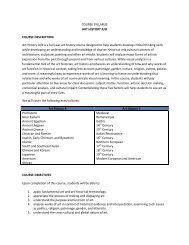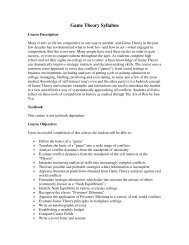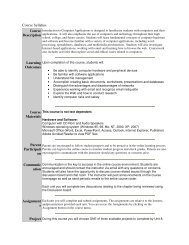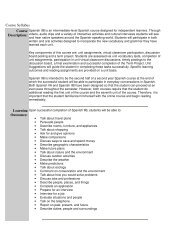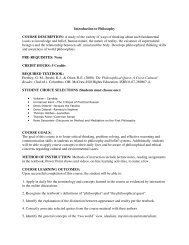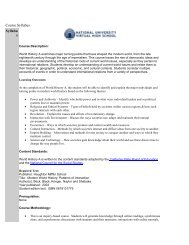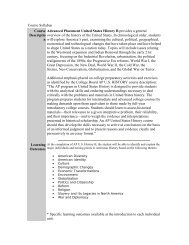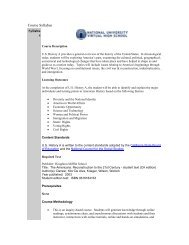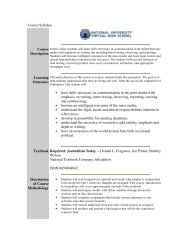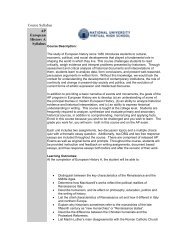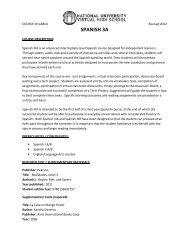AP Calculus C Course Description Calculus C is a continuation of ...
AP Calculus C Course Description Calculus C is a continuation of ...
AP Calculus C Course Description Calculus C is a continuation of ...
Create successful ePaper yourself
Turn your PDF publications into a flip-book with our unique Google optimized e-Paper software.
<strong>AP</strong> <strong>Calculus</strong> C<br />
<strong>Course</strong> <strong>Description</strong><br />
<strong>Calculus</strong> C <strong>is</strong> a <strong>continuation</strong> <strong>of</strong> <strong>Calculus</strong> B and <strong>is</strong> designed to provide the student with the<br />
prerequ<strong>is</strong>ite skills necessary for the Advanced Placement (<strong>Calculus</strong> BC) exam. A strong<br />
background in <strong>Calculus</strong> A and B (first year calculus) <strong>is</strong> necessary in order to be<br />
successful in th<strong>is</strong> course. The major topics explored in th<strong>is</strong> course include derivatives <strong>of</strong><br />
vector-valued and parametrically defined functions, integration by partial fractions,<br />
improper integrals, series convergence (Taylor and Maclaurin). L’Hopitals Rule, and<br />
numerous applications<br />
<strong>Course</strong> Materials<br />
The following <strong>is</strong> required <strong>of</strong> all <strong>Calculus</strong> C students:<br />
• Textbook: CALCULUS 7 th edition by Larson, Hostetler, and Edwards<br />
• Online resource: TDLC online resource (go to www.tdlc.com for subscription<br />
orders) for above text (optional)<br />
• Barron’s <strong>AP</strong> <strong>Calculus</strong> Advanced Placement Examination: Review <strong>of</strong> <strong>Calculus</strong> AB<br />
and <strong>Calculus</strong> BC 6 th edition, by Hockett<br />
• Graphing Calculator: A TI-83 or TI-84. Check with your instructor for other<br />
options.<br />
• Other Items: Access to a computer with internet access, regular and graph paper,<br />
pencils and a notebook for hardcopy organization.<br />
Learning Outcomes<br />
At the completion <strong>of</strong> <strong>Calculus</strong> C, the student will be able to:<br />
1. Use and apply integration by parts<br />
2. Evaluate trigonometric integrals<br />
3. Apply trigonometric substitution<br />
4. Apply partial fractions to evaluating integrals<br />
5. Apply L’Hopitals Rule and recognize indeterminant forms.<br />
6. Understand the differences and similarities between a sequence and series<br />
7. Know the Integral Test and p-Series<br />
8. Recognize different types <strong>of</strong> series<br />
9. Apply the Ratio and Root Tests<br />
10. Determine Taylor polynomials and approximations<br />
11. Use Power Series to represent functions<br />
12. Determine Taylor and Maclaurin Series.<br />
13. Apply parametric equations to calculus concepts
14. Apply polar coordinates to calculus concepts<br />
15. Determine area and arc length in polar coordinates<br />
16. Apply vectors to calculus concepts<br />
17. Apply Euler’s Method<br />
<strong>Course</strong> Outline-<strong>Calculus</strong> C<br />
The following <strong>is</strong> an overview <strong>of</strong> <strong>Calculus</strong> C course content. Students are encouraged to<br />
print th<strong>is</strong> document for reference and pacing throughout the course.<br />
Unit One<br />
LEARNING OUTCOMES (Unit One)<br />
At the end <strong>of</strong> unit one, students will be able to:<br />
• Review basic integration rules<br />
• Find antiderivatives by integration by parts (with tabular methods)<br />
• Solve trigonometric integrals<br />
• Use trigonometric substitution<br />
• Apply trigonometric integrals to real life situations<br />
REQUIRED READING (Unit One)<br />
The following <strong>is</strong> required reading for the first unit.<br />
section<br />
title<br />
7.1 Basic Integration Rules<br />
7.2 Integration by Parts<br />
7.3 Trigonometric Integrals<br />
7.4 Trigonometric Substitution<br />
TOPIC LECTURES (Unit One)<br />
In addition to the required reading, topic lectures are provided to support different<br />
learning styles through guided examples, simulation, animation and editable graphs.<br />
These can be accessed by students with a subscription at the following address:<br />
www.tdlc.com<br />
For unit one, students will access the guided examples, simulations, animations and<br />
edible graphs for the sections covered in the required reading. Students are then asked to<br />
try each section quiz (will not be graded) to check for understanding.<br />
ASSIGNMENTS (Unit One)<br />
• Exerc<strong>is</strong>es from the book (see “week one exerc<strong>is</strong>es” for a detailed l<strong>is</strong>t)
CHATS (Unit One)<br />
Students are required to attend one chat per unit (5 points each). Bring any questions or<br />
comments.<br />
DISCUSSION BOARD (Unit One)|<br />
Answer two <strong>of</strong> the following:<br />
1. Introduce yourself. Why are you taking an online course?<br />
2. Describe how you plan to be successful in <strong>Calculus</strong> C.<br />
3. Write the fraction 1/6 as the sum <strong>of</strong> two fractions.<br />
4. Make up your own example <strong>of</strong> an integration problem that requires the technique<br />
<strong>of</strong> partial fractions. Show your solution.<br />
5. What two trigonometric identities play an important role in section 7.2?<br />
TEST (Unit One)<br />
Learning Outcomes Assessment<br />
STANDARDS ADDRESSED (Unit One)<br />
Referring to the syllabus, the following NCTM Standards are addressed during week<br />
three: 1, 2, 6, 9. The following California State Board <strong>of</strong> Education Standards are<br />
addressed during week three: 17.0<br />
Unit Two<br />
LEARNING OUTCOMES (Unit Two)<br />
• At the end <strong>of</strong> week one, students will be able to:<br />
• Use and apply partial fraction decomposition.<br />
• Understand indeterminate forms for limits<br />
• Apply L’Hopital’s Rule for indeterminant forms<br />
• Evaluate integrals with infinite limits <strong>of</strong> integration.<br />
• Evaluate a limit containing asymptotic d<strong>is</strong>continuities.<br />
• L<strong>is</strong>t the terms <strong>of</strong> a sequence<br />
• Determine if a sequence converges or diverges<br />
• Write formulas for sequences<br />
• Recognize monotonic and bounded sequences<br />
REQUIRED READING (Unit Two)<br />
The following <strong>is</strong> required reading for the second unit.<br />
section<br />
title<br />
7.5 Partial Fractions<br />
7.7 Indeterminate Forms and<br />
L’Hopital’s Rule<br />
7.8 Improper Integrals<br />
8.1 Sequences
TOPIC LECTURES (Unit Two)<br />
In addition to the required reading, topic lectures are provided to support different<br />
learning styles through guided examples, simulation, animation and editable graphs.<br />
These can be accessed by students with a subscription at the following address:<br />
www.tdlc.com<br />
For unit two, students will access the guided examples, simulations, animations and<br />
edible graphs for the sections covered in the required reading. Students are then asked to<br />
try each section quiz (will not be graded) to check for understanding.<br />
ASSIGNMENTS (Unit Two)<br />
• Exerc<strong>is</strong>es from the textbook (see “Unit Two Assignments”)<br />
• Consider project options; decide on which project you would like to begin.<br />
CHATS (Unit Two)<br />
Students are required to attend one chat per unit (5 points each). Bring any questions or<br />
comments.<br />
DISCUSSION BOARD (Unit Two)<br />
Answer two <strong>of</strong> the following:<br />
1. The process <strong>of</strong> partial fractions <strong>is</strong> the reverse process <strong>of</strong>….Give an example.<br />
2. A circle has center (1,0) and radius 3. What <strong>is</strong> the area <strong>of</strong> the region bounded by<br />
the circle and the lines x = -1 and x = 2. Round your answer to the nearest<br />
hundredth.<br />
3. In your own words, explain why zero divided by zero <strong>is</strong> indeterminate ( has no<br />
real number value).<br />
4. Give an example <strong>of</strong> a limit question where applying L’Hopital’s rule twice <strong>is</strong><br />
necessary in determining the limit.<br />
5. Can L’Hopital’s Rule be applied to limits that do not ex<strong>is</strong>t? Explain.<br />
TEST (Unit Two)<br />
Unit Two Test<br />
STANDARDS ADDRESSED (Unit Two)<br />
Referring to the syllabus, the following NCTM Standards are addressed during week<br />
three: 1, 2, 6. The following California State Board <strong>of</strong> Education Standards are addressed<br />
during week three: 8.0, 17.0, 20.0<br />
Unit Three<br />
LEARNING OUTCOMES (Unit Three)<br />
At the end <strong>of</strong> unit one, students will be able to:
• Know the definition for a convergent infinite series<br />
• Know all properties for an infinite geometric series and the nth-term test.<br />
• Use the Integral Test for convergence<br />
• Know properties <strong>of</strong> p-series and harmonic series<br />
• Know the Direct Compar<strong>is</strong>on and Limit Compar<strong>is</strong>on Tests for convergence and<br />
divergence.<br />
• Use the Alternating Series Test<br />
• Classify a convergent series as absolutely or conditionally convergent.<br />
• Rearrange an infinite series to obtain different results<br />
REQUIRED READING (Unit Three)<br />
The following <strong>is</strong> required reading for the third unit.<br />
section<br />
title<br />
8.2 Series and Convergence<br />
8.3 The Integral Test and the p-<br />
Series<br />
8.4 Compar<strong>is</strong>ons <strong>of</strong> Series<br />
8.5 Alternating Series<br />
TOPIC LECTURES (Unit Three)<br />
In addition to the required reading, topic lectures are provided to support different<br />
learning styles through guided examples, simulation, animation and editable graphs.<br />
These can be accessed by students with a subscription at the following address:<br />
www.tdlc.com<br />
For unit three, students will access the guided examples, simulations, animations and<br />
edible graphs for the sections covered in the required reading. Students are then asked to<br />
try each section quiz (will not be graded) to check for understanding.<br />
ASSIGNMENTS (Unit Three)<br />
• Exerc<strong>is</strong>es from the textbook (see “Unit Two Assignments”)<br />
• Work on projects<br />
CHATS (Unit Three)<br />
Students are required to attend one chat per unit (5 points each). Bring any questions or<br />
comments.<br />
DISCUSSION BOARD (Unit Three)<br />
Answer two <strong>of</strong> the following:<br />
1. In your own words, state the difference between a geometric series and an<br />
arithmetic series.<br />
2. Give a real-life example <strong>of</strong> a(n):
o<br />
o<br />
Infinite sequenc<br />
A geometric series<br />
3. What kind <strong>of</strong> series relates mostly to music? Give an example.<br />
4. What <strong>is</strong> the difference between a sequence and a series? Give an example <strong>of</strong> each.<br />
5. In your own words, what <strong>is</strong> meant by “conditional convergence”. Give an<br />
example.<br />
TEST (Unit Three)<br />
Unit Three Test<br />
STANDARDS ADDRESSED (Unit Three)<br />
Referring to the syllabus, the following NCTM Standards are addressed during week<br />
three: 1, 2, 4, 6, 7. The following California State Board <strong>of</strong> Education Standards are<br />
addressed during unit three: 23.0<br />
Unit Four<br />
LEARNING OUTCOMES (Unit Four)<br />
At the end <strong>of</strong> unit four, students will be able to:<br />
• Use the Ratio and Root Tests to determine if a series converges or diverges.<br />
• Find polynomial approximations <strong>of</strong> parent functions.<br />
• Find Taylor and Maclaurin polynomial approximations <strong>of</strong> functions.<br />
• Use the remainder <strong>of</strong> a Taylor polynomial.<br />
• Define power series.<br />
• Find the radius and interval <strong>of</strong> convergence <strong>of</strong> a power series.<br />
• Find the endpoint convergence <strong>of</strong> a power series.<br />
• Differentiate and integrate a power series.<br />
• Find a geometric power series for a given function.<br />
• Construct a power series using operations<br />
REQUIRED READING (Unit Four)<br />
The following <strong>is</strong> required reading for the fourth unit.<br />
section<br />
Title<br />
8.6 The Ratio and Root Tests<br />
8.7 Taylor Polynomials and<br />
Approximations<br />
8.8 Power Series<br />
8.9 Representations <strong>of</strong> Functions by<br />
Power Series
TOPIC LECTURES (Unit Four)<br />
In addition to the required reading, topic lectures are provided to support different<br />
learning styles through guided examples, simulation, animation and editable graphs.<br />
These can be accessed by students with a subscription at the following address:<br />
www.tdlc.com<br />
For unit four, students will access the guided examples, simulations, animations and<br />
edible graphs for the sections covered in the required reading. Students are then asked to<br />
try each section quiz (will not be graded) to check for understanding.<br />
ASSIGNMENTS (Unit Four)<br />
• Exerc<strong>is</strong>es from the textbook (see “Unit four Assignments”)<br />
• Work on projects<br />
CHATS (Unit Four)<br />
Students are required to attend one chat per unit (5 points each). Bring any questions or<br />
comments.<br />
DISCUSSION BOARD (Unit Four)<br />
Answer two <strong>of</strong> the following:<br />
1. Describe the condition(s) <strong>of</strong> convergence for a geometric series. Give a specific<br />
example.<br />
2. Describe the condition(s) <strong>of</strong> convergence for a telescoping series. Give a specific<br />
example.<br />
3. Give an example <strong>of</strong> an infinite series that A) converges and B) diverges.<br />
4. Give a very brief biographical description <strong>of</strong> the mathematician Brook Taylor.<br />
5. Give an example <strong>of</strong> a series whose radius <strong>of</strong> convergence <strong>is</strong> R = 1.<br />
TEST (Unit Four)<br />
Unit Four Test<br />
STANDARDS ADDRESSED (Unit Four)<br />
Referring to the syllabus, the following NCTM Standards are addressed during unit four:<br />
1, 2, 4, 6. The following California State Board <strong>of</strong> Education Standards are addressed<br />
during unit four: 23.0, 24.0, 25.0, 26.0.<br />
Unit Five<br />
LEARNING OUTCOMES (Unit Five)<br />
At the end <strong>of</strong> unit five, students will be able to:<br />
• Find a Taylor and Maclaurin Series
• Find a Binomial Series<br />
• Graph parametric equations<br />
• Eliminate the parameter, given a pair <strong>of</strong> parametric equations<br />
• Find the slope <strong>of</strong> a tangent line to a curve given in parametric equations<br />
• Find arc length and surface area given a pair <strong>of</strong> parametric equations<br />
• Graph an equation given in polar coordinates<br />
• Differentiate between polar and rectangular forms<br />
• Find the slope <strong>of</strong> a tangent line for an equation given in polar form<br />
• Identify classic polar graphs<br />
REQUIRED READING (Unit Five)<br />
The following <strong>is</strong> required reading for the fifth unit.<br />
section<br />
title<br />
8.10 Taylor and Maclaurin series<br />
9.2 Plane Curves and Parametric<br />
Equations<br />
9.3 Parametric Equations and<br />
<strong>Calculus</strong><br />
9.4 Polar Coordinates and Polar<br />
Graphs<br />
TOPIC LECTURES (Unit Five)<br />
In addition to the required reading, topic lectures are provided to support different<br />
learning styles through guided examples, simulation, animation and editable graphs.<br />
These can be accessed by students with a subscription at the following address:<br />
www.tdlc.com<br />
For unit five, students will access the guided examples, simulations, animations and<br />
edible graphs for the sections covered in the required reading. Students are then asked to<br />
try each section quiz (will not be graded) to check for understanding.<br />
ASSIGNMENTS (Unit Five)<br />
• Exerc<strong>is</strong>es from the textbook (see “Unit Five Assignments”)<br />
• Work on projects<br />
CHATS (Unit Five)<br />
Students are required to attend one chat per unit (5 points each). Bring any questions or<br />
comments.<br />
DISCUSSION BOARD (Unit Five)<br />
Answer two <strong>of</strong> the following:<br />
1. How are the projects going? Any suggestions or input regarding the projects?
2. Give a brief biography for Colin Maclaurin. Include dates and contributions to<br />
mathematics.<br />
3. What <strong>is</strong> a transcendental function? Give an example <strong>of</strong> a function that <strong>is</strong><br />
transcendental and one that <strong>is</strong> not transcendental.<br />
4. In d<strong>is</strong>cussing parametric equations, what variable <strong>is</strong> referred to as the parameter?<br />
How are parametric equations applied in real life situations?<br />
5. What two mathematicians are most likely responsible for the creation <strong>of</strong> polar<br />
coordinates? How are polar coordinates applied in real life situations?<br />
TEST (Unit Five)<br />
Unit Five Test<br />
STANDARDS ADDRESSED (Unit Five)<br />
Referring to the syllabus, the following NCTM Standards are addressed during week<br />
five: 1, 2, 3, 4, 7, 9. The following California State Board <strong>of</strong> Education Standards are<br />
addressed during unit five: 26.0<br />
Unit Six<br />
LEARNING OUTCOMES (Unit Six)<br />
At the end <strong>of</strong> unit six, students will be able to:<br />
• Find the area <strong>of</strong> a region defined in polar coordinates<br />
• Find the arclength <strong>of</strong> a polar graph<br />
• Find the area <strong>of</strong> surface revolution defined in polar coordinates<br />
• Perform all vector operations and comprehend vectors geometrically<br />
• Use vectors in problem solving<br />
• Understand space coordinates and space vectors<br />
• Problem solve using space vectors<br />
• Determine angles between two vectors using dot products<br />
REQUIRED READING (Unit Six)<br />
The following <strong>is</strong> required reading for the sixth unit.<br />
section title<br />
9.5 Area and Arc Length in Polar<br />
Coordinates<br />
10.1 Vectors in the Plane<br />
10.2 Space Coordinates and Vectors<br />
in the Plane<br />
10.3 The Dot Product <strong>of</strong> Two<br />
Vectors<br />
TOPIC LECTURES (Unit Six)<br />
In addition to the required reading, topic lectures are provided to support different<br />
learning styles through guided examples, simulation, animation and editable graphs.
These can be accessed by students with a subscription at the following address:<br />
www.tdlc.com<br />
For unit six, students will access the guided examples, simulations, animations and edible<br />
graphs for the sections covered in the required reading. Students are then asked to try<br />
each section quiz (will not be graded) to check for understanding.<br />
ASSIGNMENTS (Unit Six)<br />
• Unit Six Assignments<br />
• Work on projects<br />
CHATS (Unit Six)<br />
Students are required to attend one chat per unit (5 points each). Bring any questions or<br />
comments.<br />
DISCUSSION BOARD (Unit Six)<br />
Answer two <strong>of</strong> the following:<br />
1. Use your graphing calculator to graph the line segment defined parametrically by x<br />
= 2T and y = -3T (made sure you are in parametric mode in your calculator). What <strong>is</strong> the<br />
length <strong>of</strong> the line segment whose endpoints are T = 2.5 and T = 6.1? Round your answer<br />
to two decimal places. Explain your method.<br />
2. Find the area <strong>of</strong> the polar region r = 4 using two different methods. Give your<br />
answer and explain those methods to the class.<br />
3. In your own words, explain Kepler’s First Law <strong>of</strong> Planetary motion. Do you think<br />
th<strong>is</strong> Law <strong>is</strong> in any related to the four seasons we have on planet earth?<br />
4. Give some specific contributions and a brief biography <strong>of</strong> the mathematician Emmy<br />
Noether.<br />
5. Give two real life examples <strong>of</strong> two vectors that are orthogonal.<br />
TEST (Unit Six)<br />
Unit Six Test<br />
STANDARDS ADDRESSED (Unit Six)<br />
Referring to the syllabus, the following NCTM Standards are addressed during week six:<br />
1, 2, 3, 4, 8, 9. The following California State Board <strong>of</strong> Education Standards are<br />
addressed during unit six: 16.0, 20.0<br />
Unit Seven<br />
LEARNING OUTCOMES (Unit Seven)<br />
At the end <strong>of</strong> unit seven, students will be able to:<br />
• Find the cross-product <strong>of</strong> two vectors in space and use the triple scalar product.<br />
• Draw and analyze a space curve given in vector-valued terms.
• Extend single-variable calculus concepts to vector calculus.<br />
• Differentiate and integrate vector-valued functions.<br />
• Describe velocity and acceleration <strong>of</strong> vector-valued functions.<br />
• Analyze projectile motion<br />
REQUIRED READING (Unit Seven)<br />
The following <strong>is</strong> required reading for the seventh unit.<br />
section<br />
title<br />
10.4 The Cross Product <strong>of</strong> Two<br />
Vectors in Space<br />
11.1 Vector Valued Functions<br />
11.2 Differentiation and Integration<br />
<strong>of</strong> Vector-Valued Functions<br />
11.3 Velocity and Acceleration<br />
TOPIC LECTURES (Unit Seven)<br />
In addition to the required reading, topic lectures are provided to support different<br />
learning styles through guided examples, simulation, animation and editable graphs.<br />
These can be accessed by students with a subscription at the following address:<br />
www.tdlc.com<br />
For unit seven, students will access the guided examples, simulations, animations and<br />
edible graphs for the sections covered in the required reading. Students are then asked to<br />
try each section quiz (will not be graded) to check for understanding.<br />
ASSIGNMENTS (Unit Seven)<br />
• Unit seven assignments<br />
• Work on projects<br />
CHATS (Unit Seven)<br />
Students are required to attend one chat per unit (5 points each). Bring any questions or<br />
comments.<br />
DISCUSSION BOARD (Unit Seven)<br />
Answer two <strong>of</strong> the following:<br />
1. Is the cross-product <strong>of</strong> two vectors commutative? Give and example or a<br />
counterexample to illustrate your point.<br />
2. Give three examples <strong>of</strong> how torque <strong>is</strong> used in real life situations.<br />
3. Give your own example <strong>of</strong> a vector valued function in space that has the<br />
following domain: “ALL REAL NUMBERS GREATER THAN ZERO”.
4. Give a vector-valued equation for a circle. Give a vector-valued equation <strong>of</strong> a<br />
sphere.<br />
5. In your own words, explain how vector calculus differs from calculus <strong>of</strong> a single<br />
variable (th<strong>is</strong> <strong>is</strong> the calculus found in 1 st and 2 nd semester calculus).<br />
TEST (Unit Seven)<br />
Unit Seven Test<br />
STANDARDS ADDRESSED (Unit Seven)<br />
Referring to the syllabus, the following NCTM Standards are addressed during week<br />
seven: 1, 2, 3, 4, 6, 7, 8, 9 . The following California State Board <strong>of</strong> Education Standards<br />
are addressed during unit seven: 6.0<br />
Unit Eight<br />
LEARNING OUTCOMES (Unit Eight)<br />
At the end <strong>of</strong> unit eight, students will be able to:<br />
• Make connections between projects and learning outcomes for th<strong>is</strong> course.<br />
• Demonstrate knowledge <strong>of</strong> trigonometry sufficient for placement in higher<br />
mathematics.<br />
• Understand and apply Euler’s Method<br />
REQUIRED READING (Unit Eight)<br />
Students are asked to review prior readings in preparation for the final exam. Students<br />
should carefully read and re-read Euler’s method on page A3 in the text. Students should<br />
also v<strong>is</strong>it the recommended websites for Euler’s Method (see Topic Lectures for week 8)<br />
TOPIC LECTURES (Unit Eight)<br />
In addition to the required reading, topic lectures are provided to support different<br />
learning styles through guided examples, simulation, animation and editable graphs.<br />
These can be accessed by students with a subscription at the following address:<br />
www.tdlc.com<br />
For unit eight, students will access the guided examples, simulations, animations and<br />
edible graphs for the sections covered in the required reading. Students are then asked to<br />
try each section quiz (will not be graded) to check for understanding.<br />
ASSIGNMENTS (Unit Eight)<br />
• Review exerc<strong>is</strong>es<br />
• Complete and turn in projects to the instructor.<br />
CHATS (Unit Eight)<br />
Students are required to attend one chat per unit (5 points each). Bring any questions or<br />
comments.
TEST (Unit Eight)<br />
Final Exam<br />
DISCUSSION BOARD (Unit Eight)<br />
Answer two <strong>of</strong> the following:<br />
1. What areas do I need to focus on the most in order to prepare for the final exam?<br />
2. Describe Euler’s method in your own words. In what situation might a person<br />
have to use Euler’s Method?<br />
3. Have I completed and turned in my projects?<br />
4. What formulas do I need to be familiar with before I take the final exam?<br />
5. Do I plan to take the <strong>AP</strong> <strong>Calculus</strong> BC Exam? How am I going to prepare? What<br />
additional resources are available for practice?<br />
STANDARDS ADDRESSED (Unit Eight)<br />
Referring to the syllabus, the following NCTM Standards are addressed during week<br />
eight: 1, 2, 3, 4, 8. The following California State Board <strong>of</strong> Education Standards are<br />
addressed during unit eight: 20.0, 27.0<br />
To Parents<br />
Parents are encouraged to monitor student progress wherever appropriate and to be<br />
proactive in their child’s learning. Parents can obtain a copy <strong>of</strong> the course outline on the<br />
course website. Parents will be contacted throughout the course to update student<br />
progress. Parents are also encouraged to communicate with the instructor should any<br />
questions or concerns ar<strong>is</strong>e.<br />
To Be Successful in th<strong>is</strong> Class<br />
Being proactive about your progress and learning in th<strong>is</strong> course <strong>is</strong> your key to success!<br />
You are the one who needs to be in charge <strong>of</strong> your learning. Successful students will do<br />
all the following:<br />
· Do the required reading.<br />
· Carefully read and retry the examples/exerc<strong>is</strong>es from the text.<br />
· V<strong>is</strong>it all teacher recommended websites and do all <strong>of</strong> the activities suggested in<br />
the topic lectures for each week.<br />
· Ask questions wherever possible. Be assertive about your learning!<br />
· Be involved with online chats and d<strong>is</strong>cussions.<br />
· Submit all assignments, projects, and tests on time.<br />
· Pace yourself! Budget and plan your time carefully.<br />
· Start your projects when suggested.<br />
Assessment
Both formal and informal assessments methods will be employed. Informal assessment<br />
will include an evaluation <strong>of</strong> participation in unit chats and d<strong>is</strong>cussions and grading<br />
rubrics for projects and assignments. Formal assessment will be employed for tests and<br />
the final examinations.<br />
Total point values for all categories are as follows:<br />
ASSIGNMENTS 160<br />
points<br />
TESTS 300<br />
points<br />
CHATS 40<br />
points<br />
DISCUSSIONS 80<br />
points<br />
PROJECTS 200<br />
points<br />
FINAL EXAM 100<br />
points<br />
Unit assignments are worth 20 points and should<br />
be submitted to the instructor.<br />
There will be a total <strong>of</strong> 6 tests (Units 2 to 7 only),<br />
50 points each. Tests should be taken after<br />
assignments for the unit have been completed.<br />
There will be a total <strong>of</strong> 8 chats, 5 points each.<br />
There will be a total <strong>of</strong> 8 d<strong>is</strong>cussions, 10 points<br />
each. Answers to be posted on DISCUSSION<br />
BOARD<br />
There will be two projects, 100 points each.<br />
Submit projects electronically.<br />
The final exam should be taken at the end <strong>of</strong> the<br />
8 th unit.<br />
Grading Scale<br />
Th<strong>is</strong> course <strong>is</strong> worth a total <strong>of</strong> 880 points. Your final grade will be determined according<br />
to the following:<br />
POINTS GRADE<br />
818-880 A<br />
787-817 A-<br />
774-786 B+<br />
730-773 B<br />
699-729 B-<br />
686-698 C+<br />
642-685 C<br />
612-641 C-<br />
528-611 D<br />
< 528 F<br />
Time Management<br />
Since th<strong>is</strong> full semester course <strong>is</strong> completed in eight- sixteen weeks, you should expect to<br />
spend 12-15 hours per week on the assignments, d<strong>is</strong>cussions, chats, tests, and projects.
Using the Equation Editor<br />
Equation Editor, available on Micros<strong>of</strong>t Word, allows students and teachers to write<br />
mathematical expressions and equations directly onto a Word document. Th<strong>is</strong> option <strong>is</strong><br />
especially useful with online math courses because it <strong>is</strong> easy to use with Blackboard and<br />
email. The following instructions will help to make Equation Editor accessible on your<br />
toolbar.<br />
Begin by opening a blank Word document. Go to View, then to Toolbars, then to<br />
Customize. Under “categories”, click on Insert. Under “commands”, find Equation<br />
Editor. Drag Equation Editor up to your toolbar (anywhere on the toolbar will be fine).<br />
The button on your toolbar will look like a square root symbol.<br />
You should now practice using Equation Editor on a blank Word document until you<br />
can use it comfortably.<br />
Standards Addressed<br />
Both National Council <strong>of</strong> Teachers <strong>of</strong> Mathematics (NCTM) and California State Board<br />
<strong>of</strong> Education Mathematics Content Standards are addressed throughout th<strong>is</strong> course.<br />
A summary <strong>of</strong> NCTM standards are l<strong>is</strong>ted as follows. Detailed learning expectations for<br />
each <strong>of</strong> the following can be viewed on the NCTM website.<br />
1. Number and Operations<br />
2. Algebra<br />
3. Geometry<br />
4. Measurement<br />
5. Data Analys<strong>is</strong> and Probability<br />
6. Problem Solving<br />
7. Reasoning and Pro<strong>of</strong><br />
8. Communication<br />
9. Representation<br />
California State Board <strong>of</strong> Education Standards for Mathematics can be viewed at:<br />
http://www.cde.ca.gov/be/st/ss/mthtrig.asp




